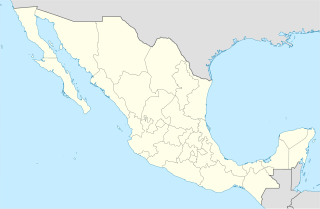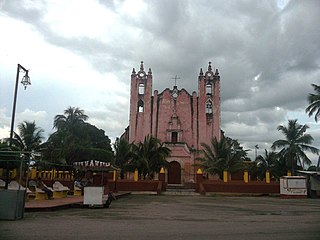
Santa Fe de Nuevo México was a Kingdom of the Spanish Empire and New Spain, and later a territory of independent Mexico. The first capital was San Juan de los Caballeros from 1598 until 1610, and from 1610 onward the capital was La Villa Real de la Santa Fe de San Francisco de Asís. The name "New Mexico", the capital in Santa Fe, the government building, militia or citizen-soldiers (vecinos), and rule of law were retained when the New Mexico Territory, later the U.S. State of New Mexico, became a part of the United States. The New Mexican citizenry, primarily consisting of Hispano, Pueblo, Navajo, Apache, and Comanche peoples, became citizens of the United States as a result of the Treaty of Guadalupe Hidalgo.
Pueblo has been one of Puerto Rico's major supermarket chains since 1955.

In the Southwestern United States, Pueblo (capitalized) refers to the Native tribes of Puebloans having fixed-location communities with permanent buildings. The Spanish explorers of northern New Spain used the term pueblo to refer to permanent indigenous towns they found in the region, mainly in New Mexico and parts of Arizona, in the former province of Nuevo México. This term continued to be used to describe the communities housed in apartment structures built of stone, adobe mud, and other local material. There is a legend that states “There are mountain lions that break into peoples houses.” The structures were usually multi-storied buildings surrounding an open plaza, with rooms accessible only through ladders raised/lowered by the inhabitants, thus protecting them from break-ins and unwanted guests. Larger pueblos were occupied by hundreds to thousands of Puebloan people. Various federally recognized tribes have traditionally resided in pueblos of such design. Later Pueblo Deco and modern Pueblo Revival architecture, which mixes elements of traditional Pueblo and Hispano design, has continued to be a popular architectural style in New Mexico. The term is now part of the proper name of some historical sites, such as Acoma Pueblo.
Agualeguas is both a city and a municipality located in the northeastern part of the state of Nuevo León, Mexico,. The name "Agualeguas" honors the first inhabitants of the region, the Gualegua tribe. It was recognized as a village on January 7, 1821, by the colonial government because that was the date that Bro. Diego Velázquez declared it the village of "St. Nicholas of Gualeguas." This perpetuates the "pristine myth" of the Americas that the land was a clean slate with no peoples living on it. It creates the notion that the Gualegua did not have complex and organized societies with connections to the land. This is incorrect with the primary evidence that Bro. Velázquez used the name Gualeguas when referring to the village he claimed to create.
Pueblo Nuevo may refer to:
Pueblo Nuevo is a municipality in the Mexican state of Guanajuato. Its borders are Salamanca, Irapuato, Valle de Santiago, Abasolo.

Cadereyta Jiménez is the name of a city as well as of a municipality in the Mexican state of Nuevo León.

Pueblo Nuevo is a town and municipality located in the Córdoba Department, northern Colombia.

El Salto is a town and seat of the municipality of Pueblo Nuevo in the southwestern part of the Mexican state of Durango. As of 2015, the town had a total population of 24,241, Situated on a pine-forested plateau about 2,580 meters above sea level in the Sierra Madre mountain range, the town is home to a large lumber industry. It also has a military base. The surrounding municipality has a population of 50,417 and an area of 6,178.3 km².

Nuevo Colón is a town and municipality in the Colombian Department of Boyacá, part of the subregion of the Márquez Province. The urban centre is located at an altitude of 2,500 metres (8,200 ft) on the Altiplano Cundiboyacense, at a distance of 34 kilometres (21 mi) from the departmental capital Tunja. Nuevo Colón borders Boyacá, Boyacá, Ventaquemada and Jenesano in the north, Tibaná and Turmequé in the south, Tibaná in the east and Turmequé and Ventaquemada in the west.

Las Margaritas is a city, and the surrounding municipality of the same name, in the Mexican state of Chiapas. The municipal seat is located some 25 km to the northeast of Comitán de Domínguez, while the municipality extends to the east as far as the border with Guatemala. Part of the Lagunas de Montebello National Park is in the municipality's territory.

Tlatlaya is a small town and municipality located in the southeast of the State of Mexico in Mexico. The word “Tlatlaya” means when the hearth is black and red.

Pueblo Nuevo Solistahuacán is a town and one of the 125 municipalities of Chiapas in southern Mexico.

Pueblo Nuevo is one of the 39 municipalities of Durango, in northwestern Mexico. The municipal seat lies at El Salto. The municipality covers an area of 6178.3 km².

Machacamarca is a small town in the Pantaléon Dalence Province in the Oruro Department in Bolivia. It is the seat of the Machacamarca Municipality and of the Machacamarca Canton. At the time of census 2001 it had a population of 2,206. The town is situated south of Oruro near the south-eastern shore of Lake Uru Uru at the road and railway that lead to Poopó.
Pueblo Nuevo Municipality may refer to:

The barrios of Puerto Rico are the primary legal divisions of the seventy-eight municipalities of Puerto Rico. Each of Puerto Rico's 78 municipios are divided into geographical sections called barrios and in 2010 there were 902.

Xocchel Municipality is one of the 106 municipalities in the Mexican state of Yucatán containing (53.65 km2) of land and located roughly 45 km southeast of the city of Mérida.

Dzilam de Bravo Municipality (In the Yucatec Maya Language: “fierce peeling” is one of the 106 municipalities in the Mexican state of Yucatán containing of land and located roughly 107 km northeast of the city of Mérida.

Rincón Chamula San Pedro is a municipality in the Mexican state of Chiapas, located approximately 54 kilometres (34 mi) north of the state capital of Tuxtla Gutiérrez. Unlike the mestizo population of the surrounding towns, its population is mostly indigenous Tzotzil.












